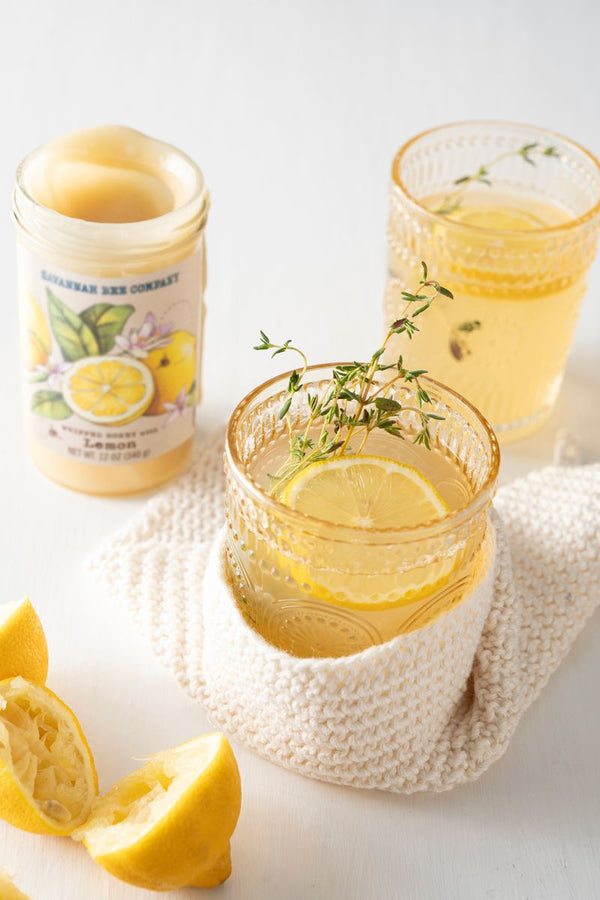What is Honeycomb?

You may have seen honeycomb in videos, beehives, or our own Savannah Bee Company stores — but what is it?
Simply put, honeycomb is a cluster of repeating hexagonal beeswax cells that act as a storage unit and safe haven for a honey bee hive.
If you take a closer look, honeycomb truly is a marvel of nature. Let’s dive in and find out why.
Why Is Honeycomb Made Of Hexagons?
Honey bees, like many other species, use the hexagon as a structural building shape because of its simplicity, strength, and durability.

The hexagon is actually considered the strongest shape.
The six sides and six corners allow it to distribute weight and pressure evenly across its structure.
Bees love it because it maximizes strength, while minimizing the amount of construction and the weight.
Of course, to them, it’s just instinct — but that just goes to show the naturally occurring genius and resiliency of nature!
Now that you know it, you’ll be noting this hexagonal pattern everywhere.
Many plant species use the hexagon in the structure of the xylem tissue, the tissue that moves water from the plant’s roots to its leaves for photosynthesis.
Hexagons also appear in the bone tissue of many animals. The hexagon helps with bone strength but also allows them to be lightweight. This enhances mobility without creating undue stress on skeletal muscle groups.
While honeybees may be the most famous users of the hexagon, they’re not the only insect to employ this brilliant design.
Paper wasps also construct their nests from wood fiber using the iconic honeycomb pattern.
And although paper wasps don’t produce honey, they do use hexagonal cells for developing their brood (eggs, larvae, and pupae) just as the honey bee does.

What Is Beeswax?
Beeswax is the substance from which honeycomb is made.
It’s the material that composes the walls of the honeycomb, allowing those beautiful little hexagons to form and fill with honey.
We know bees are hard workers, and making beeswax is one of their many responsibilities.
The female worker bees, usually the young ones, chow down on some honey, which they digest and turn into liquid beeswax.
This liquid beeswax is processed in eight special glands and then excreted through openings on the lower abdomen.
As soon as it hits air, the wax hardens and turns into scales, which the other bees chew and soften until they can be formed into cells.
Although the scales are initially clear, they turn opaque following the chewing and reforming.
Like other waxes, beeswax is a lipid, which means it’s insoluble in water and completely rain-resistant.
When constructing their comb out of wax, bees also engage in an activity called festooning — hanging onto each other by their feet to form chains.
Festooning helps bridge gaps in the comb and provide support as they build the structure — and it looks really cool.
How Do Bees Use Honeycomb?
The biggest reason bees make honeycomb is storage — for honey and for the queen bee’s eggs.
If you think of a beehive like a house, the honeycomb makes up all the rooms, or cells, of the house.
A cell is one single hexagon in the comb, and individual cells serve the colony in different ways.
The first way we think of is, of course, honey storage.
Honey is a bee’s energy source, so they want to make sure they have a lot of room for it and it’s protected.
But some cells are also used for raising the next generation of bees.

These cells are called brood cells. Upon returning from her mating flight, the queen bee lays her eggs in these cells, which have been constructed specifically for her by her worker bees.
The brood cells will serve as incubation chambers for the developing honeybees as they grow from eggs to larva to pupa and, eventually, to a full-grown bee.
The brood cells are meticulously maintained by the female worker bees — after all, the brood is the future of the colony!
Can You Eat Honeycomb — And Is It Good For You?
Yes and yes! Honeycomb is basically beeswax and raw honey, so it’s 100% edible and safe to eat.

The beeswax alone has very little nutritional value, with the exception of trace amounts of Vitamin A.
However, since our system does not break down beeswax, it can help the body move food and waste through the gut.
The raw honey in honeycomb is very nutritious (and delicious).
It’s packed with vitamins, enzymes, pollen, and antioxidants that promote digestive health and soothe inflammation.
In fact, the most nutritious of all raw honey is the honey still sealed in the wax cells of the comb.
When removed from the comb and exposed to air, honey has a tendency to pull water from the atmosphere.
As a result, honey that is removed from the comb holds around 12% more water than honey left in the comb.
This dilution creates a slight but measurable difference in nutritional value by weight.
Honeycomb honey is left in its purest form, so it is without question the purest and most nutritious form of raw honey.
Thanks to the ingenuity and teamwork of honeybees, we get to enjoy the taste and benefits of delicious honeycomb.
The next time you’re about to dig into some golden Savannah Bee Co. honeycomb, remember to thank the bees for their hard work!
#savethebees
Published











